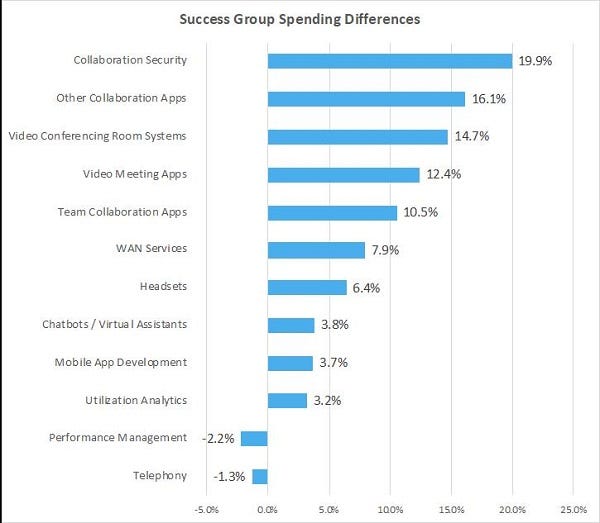5 Keys to UC Success5 Keys to UC Success
Successful companies are spending more, and are more proactive in supporting work from home.
February 3, 2021

In our recently published Workplace Collaboration: 2021-22 Research Study, Metrigy looked at the characteristics of organizations achieving measurable success from their investments in workplace collaboration technologies. This global study, based on data gathered from 476 end-user organizations across a range of sizes and verticals, identified ROI factors including cost savings and revenue gain, as well as productivity improvements.
We identified 85 participating organizations that exceeded mean benefit in one or more of these areas. We then analyzed their operational and technology deployment approaches to determine how they differed from those with low or no measured benefit, and identified major characteristics of successful organizations.
The five top characteristics are:
1. They spend more on IT — While a majority (56.5%) of participants are increasing their IT budgets for 2021, 76.5% of successful companies are doing so. Success group members are increasing spending on collaboration security, video conferencing, team collaboration, WAN services, headsets, and other collaborative applications such as virtual whiteboards and team workflow/project apps at a significantly greater percentage than the other participants.

2. They are better supporting the needs of remote workers — Successful companies allow employees to choose between working at home and working at the office versus forcing them to work at one or the other. They are twice as likely to have implemented regular social engagements such as training, games, or other team-building activities for virtual workers. And, they provide a higher level of IT support for remote workers to include assistance with home Wi-Fi, network optimization, and Internet plan selection. Successful companies are also more likely to use headset management platforms to ensure end-to-end visibility into audio quality.
3. They embrace video — Successful companies not only use video more often (for 22.6% of all meetings versus 18% of the overall participant pool), they provision more devices to improve meeting experiences. These devices include headsets, speakerphones, webcams, executive desktop systems, and lighting. In addition, 40% of our success group, compared to 20% of non-successful companies, are putting video conferencing systems into all meeting spaces to support a return to the office. Successful companies are also investing in WAN services and direct connectivity to cloud providers to optimize video performance for those in the office.
4. They embrace the cloud — Successful companies are twice as likely to have deployed UCaaS to move away from on-premises calling platforms. In addition, 76.5% of licenses among successful companies include meetings and 63.5% include team collaboration, compared to 68.5% and 59.9%, respectively, for non-successful companies. By the end of 2021, successful companies will have 76% of their employees using team collaboration (up from 64.6% today), versus just 60% (up from 49% today) of non-successful companies.
5. They are proactively addressing collaboration security — Threats against communications and collaboration platforms, as well as other IT and data assets, from increasingly sophisticated, and often nation-state attacks, have been in the news over the last year. Among successful companies, 65.5% have a proactive security strategy covering collaboration platforms (most often owned by the CISO/CSO) versus just 27.6% of non-successful companies. Approaches typically include deployment of application-aware firewalls, third-party audits and penetration testing, and active patch management. In addition, those leveraging the cloud invest time into analyzing the security capabilities of their providers.
Those looking to improve the return on their communications and collaboration investments would be wise to consider these five success correlations as they carry out their own application deployment and management strategy in the coming year.





